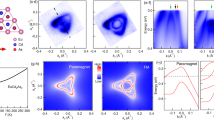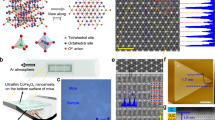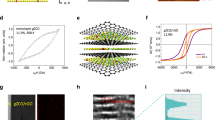Abstract
Semiconductors doped with magnetic ions, also known as dilute magnetic semiconductors, are both semiconducting and ferromagnetic. It remains unclear, however, whether this ferromagnetism is intrinsic, as is required for spintronic applications, or is due instead to dopant clustering. Here, we report conclusive evidence for intrinsic ferromagnetism in individual ZnO nanoparticles doped with transition metal ions. Through a simultaneous magnetic and microstructural characterization using electron magnetic chiral dichroism and channelling-enhanced electron energy loss microanalysis, respectively, we show that ZnO nanoparticles have intrinsic ferromagnetism when doped with cobalt, but not when doped with iron.
This is a preview of subscription content, access via your institution
Access options
Subscribe to this journal
Receive 12 print issues and online access
$259.00 per year
only $21.58 per issue
Buy this article
- Purchase on Springer Link
- Instant access to full article PDF
Prices may be subject to local taxes which are calculated during checkout





Similar content being viewed by others
References
Wolf, S. A. et al. Spintronics: a spin-based electronics vision for the future. Science 294, 1488–1495 (2001).
Sharma, P. et al. Ferromagnetism above room temperature in bulk and transparent thin films of Mn-doped ZnO. Nature Mater. 2, 673–677 (2003).
Kittilstved, K. R., Lin, W. K. & Gamelin, D. R. Electronic structure origins of polarity-dependent high-TC ferromagnetism in oxide-diluted magnetic semiconductors. Nature Mater. 5, 291–297 (2006).
Radovanovic, P. V. & Gamelin, D. R. High-temperature ferromagnetism in Ni2+-doped aggregates prepared from colloidal diluted magnetic semiconductor quantum dots. Phys. Rev. Lett. 91, 157202 (2003).
Quilty, J. W. et al. Signature of carrier-induced ferromagnetism in Ti1–xCoxO2–δ: exchange interaction between high-spin Co2+ and the Ti 3d conduction band. Phys. Rev. Lett. 96, 027202 (2006).
Neal, J. R. et al. Room-temperature magneto-optics of ferromagnetic transition-metal- doped ZnO thin films. Phys. Rev. Lett. 96, 197208 (2006).
Matsukura, F., Ohno, H., Shen, A. & Sugawara, Y. Transport properties and origin of ferromagnetism in (Ga,Mn)As. Phys. Rev. B. 57, R2037–R2040 (1997).
Toyosaki, H. et al. Anomalous Hall effect governed by electron doping in a room-temperature transparent ferromagnetic semiconductor. Nature Mater. 3, 221–224 (2004).
Shinde, S. R. et al. Co-occurrence of superparamagnetism and anomalous Hall effect in highly reduced cobalt-doped rutile TiO2–δ films. Phys. Rev. Lett. 92, 166601 (2004).
Xu, Q. Y. et al. Room-temperature ferromagnetism in ZnO films due to defects. Appl. Phys. Lett. 92, 082508 (2008).
Coey, J. M. D., Venkatesan, M. & Fitzgerald, C. B. Donor impurity band exchange in dilute ferromagnetic oxides. Nature Mater. 4, 173–179 (2005).
Venkatesan, M., Fitzgerald, C. B., Lunney, J. G. & Coey, J. M. D. Anisotropic ferromagnetism in substituted zinc oxide. Phys. Rev. Lett. 93, 177206 (2004).
Jiang, N. et al. Polarity determination by atomic location by channeling-enhanced microanalysis. Appl. Phys. Lett. 80, 389–391 (2001).
Kong, X., Hu, G. Q., Duan, X. F., Lu, Y. & Liu, X. L. Polarity determination for GaN thin films by electron energy-loss spectroscopy. Appl. Phys. Lett. 81, 1990–1992 (2002).
Liu, Y. Z. et al. Co location and valence state determination in ferromagnetic ZnO:Co thin films by atom-location-by-channeling-enhanced-microanalysis electron energy-loss spectroscopy. Appl. Phys. Lett. 90, 154101 (2007).
Wang, X. F. et al. Signature of intrinsic high-temperature ferromagnetism in cobalt-doped zinc oxide nanocrystals. Adv. Mater. 18, 2476–2480 (2006).
Hébert, C. & Schattschneider, P. A proposal for dichroic experiments in the electron microscope. Ultramicroscopy 96, 463–468 (2003).
Schattschneider, P. et al. Detection of magnetic circular dichroism using a transmission electron microscope. Nature 441, 486–488 (2006).
Stöhr, J. Exploring the microscopic origin of magnetic anisotropies with X-ray magnetic circular dichroism (XMCD) spectroscopy. J. Magn. Magn. Mater. 200, 470–497 (1999).
Egerton, R. F. Electron Energy Loss Spectroscopy in the Electron Microscope 2nd edn (Plenum Press, 1996).
Kittel, C. Introduction to Solid States Physics 7th edn (Wiley, 1996).
Muller, S., Zhou, M. J., Li, Q. & Ronning, C. Intra-shell luminescence of transition-metal-implanted zinc oxide nanowires. Nanotechnology 20, 135704 (2009).
Schattschneider, P. et al. Magnetic circular dichroism in EELS: Towards 10 nm resolution. Ultramicroscopy 108, 433–438 (2008).
Acknowledgements
The authors are grateful to X.F. Duan and R.C. Che for the use of the Lorentz microscope, and B. Zhang and X.X. Zhang for the SQUID measurements. Q.L. thanks H.Q. Lin and L.J. Sham for stimulating discussions and valuable suggestions. This work was supported by grants from the RGC of Hong Kong (CUHK 402007 and N_CUHK447/07), UGC SEG (CUHK06), CUHK Focused Investments Scheme C and DFG of the Priority Program 1165 (1198/7-3).
Author information
Authors and Affiliations
Contributions
Z.H.Z. and Q.L. conceived and designed the experiments, analysed the data and co-wrote the paper. Z.H.Z. performed the electron microscopy experiments. S.M. contributed iron-doped materials and X.F.W. contributed cobalt-doped ZnO materials. S.M., X.F.W., C.R. and J.B.X. performed the magnetic and optical characterizations on a macroscopic scale and analysed the data. All authors discussed the results and commented on the manuscript.
Corresponding author
Supplementary information
Supplementary information
Supplementary information (PDF 2069 kb)
Rights and permissions
About this article
Cite this article
Zhang, Z., Wang, X., Xu, J. et al. Evidence of intrinsic ferromagnetism in individual dilute magnetic semiconducting nanostructures. Nature Nanotech 4, 523–527 (2009). https://doi.org/10.1038/nnano.2009.181
Received:
Accepted:
Published:
Issue Date:
DOI: https://doi.org/10.1038/nnano.2009.181
This article is cited by
-
Structural, optical ellipsometry, and magnetic characteristics of iron-doped zinc oxide thin films for spintronic applications
Journal of Materials Science: Materials in Electronics (2023)
-
Direct investigation of the atomic structure and decreased magnetism of antiphase boundaries in garnet
Nature Communications (2022)
-
Structural, optical, and magnetic properties of iron-doped ZnO nanoparticles for optoelectronics
Journal of Materials Science: Materials in Electronics (2022)
-
Tunable room-temperature ferromagnetism in Co-doped two-dimensional van der Waals ZnO
Nature Communications (2021)
-
Photoluminescence and intrinsic ferromagnetism of Fe doped zinc oxide
SN Applied Sciences (2020)



